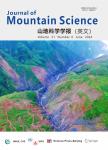Impact of temperature and precipitation lapse rate on hydrological modelling over Himalayan Gandak River Basin
Impact of temperature and precipitation lapse rate on hydrological modelling over Himalayan Gandak River Basin作者机构:Department of Hydraulic and Water Resource EngineeringBule Hora UniversityBule Hora 144Ethiopia Department of Civil EngineeringMadanapalle Institute of Technology&ScienceMadanapalle 517325India Engineering Systemsand EnvironmentUniversityof VirginiaCharlottesvilleVA22904USA
出 版 物:《Journal of Mountain Science》 (山地科学学报(英文))
年 卷 期:2022年第19卷第12期
页 面:3487-3502页
核心收录:
学科分类:0830[工学-环境科学与工程(可授工学、理学、农学学位)] 08[工学] 081501[工学-水文学及水资源] 0815[工学-水利工程]
主 题:Streamflow SWAT-ETISM Himalayan Regions Water balance Temperature lapse rate Precipitation lapse rate
摘 要:The hydrology of Himalayan region is influenced by temperature lapse rate(TLAPS)and precipitation lapse rate(PLAPS).Therefore,hydrological modeling considering TLAPS and PLAPS is crucial to manage the water resources in these terrains.In this research,Himalayan Gandak River basin is considered as the study area where TLAPS and PLAPS vary significantly due to high altitude of Himalayas.To assess the impact of TLAPS and PLAPS on water balance components,Soil Water Assessment Tool(SWAT)model was calibrated(2000-2007)and validated(2008-2014)on daily time step for three projects i.e.,Reference Project(RP),Snowmelt Project(SP)and distributed elevation band snowmelt project(SWAT-ETISM).The analysis discloses that SWAT-ETISM model(which has TLAPS and PLAPS parameters)outperforms the RP and the SP models in predicting streamflow with improved statistical indicators R2=0.88,NSE=0.84 and PBIAS=11.9.Furthermore,it was observed that SWAT-ETISM model comprehensively improved the streamflow statistics by improving the snow water equivalent and water balance components through the consideration of TLAPS and PLAPS values for the region.Hence,the proposed SWAT-ETISM model can be used for estimation of the water budget at the high-altitude and data scarce alpine Himalayan regions and worldwide,where PLAPS and TLAPS are substantial due to altitudinal variation.



